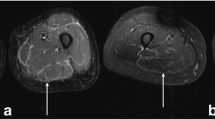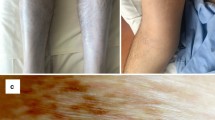Abstract
Current concepts of the pathophysiology of necrotizing fasciitis (NF), a life-threatening infection of soft tissues associated with a toxic shock syndrome, emphasizes the role of bacterial superantigens as mediators of cytokine release by immune lymphocytes. In order to assess the cellular basis of immune activation, immunohistochemistry was applied to the analysis of inflammatory cell subsets in situ in 13 patients with NF. The percentage of inflammatory cells in skin and soft tissue was scored from 0 to 3+ (>50%). Substantial numbers of CD15+ polymorphonuclear leukocytes were present in 12 of 13 patients. CD3+ T-lymphocytes accounted for >10%, CD68+ macrophages for >50%, and Factor XIIIa+ mononuclear cells for >10% of the mononuclear cell infiltrates, respectively, in 10 of 13 patients, whereas CD1a+ cells were present in only 3 of 13 cases and accounted for <10% of mononuclear inflammatory cells. We conclude that immune lymphocytes and accessory immune cells are represented in substantial numbers in the early lesions of NF, and their presence supports current concepts with respect to the pathophysiology of this disorder.




Similar content being viewed by others
References
Salcido R (2007) Necrotizing fasciitis: reviewing the causes and treatment strategies. Adv Skin Wound Care 20:288–293
Miller LG, Perdreau Remington F, Rieg G et al (2005) Necrotizing fasciitis caused by community-acquired methicillin resistant Staphylococcus aureus in Los Angeles. N Engl J Med 352:1445–1451
Roldan CJ (2007) Necrotizing fasciitis. J Emerg Med 16:1–2
Stamenkovic I, Lew PD (1984) Early recognition of potentially fatal necrotizing fasciitis. The use of frozen-section biopsy. N Engl J Med 310:1689–1693
Wong C, Wang Y (2005) The diagnosis of necrotizing fasciitis. Curr Open Infect Dis 18:101–106
Bisno AL, Stevens DL (1996) Streptococcal infections of skin and soft tissues. N Engl J Med 334:240–245
Stevens DL (1992) Invasive group A streptococcus infections. Clin Infect Dis 14:2–11
Wang YS, Wong CH, Tay YK (2007) Staging of necrotizing fasciitis based on the evolving cutaneous features. Int J Dermatol 46:1036–1041
Dahl PR, Perniciaro C, Holmkvist KA, O'Connor MI, Gibson LE (2002) Fulminant group A streptococcal necrotizing fasciitis: clinical and pathologic findings in 7 patients. J Am Acad Dermatol 47:489–492
Stevens DL, Tanner MH, Winship J (1989) Severe group A streptococcal infections associated with a toxic shock-like syndrome and scarlet fever toxin A. N Eng J Med 321:1–7
Hauser AR, Stevens DL, Kaplan EL, Schlievert PM (1991) Molecular analysis of pyrogenic exotoxins from Streptococcus pyogenes isolates associated with toxic shock-like syndrome. J Clin Microbiol 29:1562–1567
Marrack P, Kapler JW (1990) The staphylococcal enterotoxins and their relatives. Science 248:705–711
Green RJ, Dafoe DC, Raffin TA (1996) Necrotizing fasciitis. Chest 110:219–229
Mollick JA, Rich RR (1991) Characterization of a superantigen from a pathogenic strain of Streptococcus pyogenes. Clin Res 39:213A
Hackett SP, Stevens DL (1992) Streptococcal toxic shock syndrome: synthesis of tumor necrosis factor and interleukin-1 by monocytes stimulated with pyrogenic exotoxin A and streptolysin O. J Infect Dis 165:879–885
Fast DJ, Schlievert PM, Nelson RD (1989) Toxic shock syndrome-associated staphylococcal and streptococcal pyrogenic toxins are potent inducers of tumor necrosis factor production. Infec Immun 57:291–294
Norrby-Teglund A, Newton D, Kotb M (1994) Superantigenic properties of the group A streptococcal exotoxin SpeF (MF). Infec Immun 62:5227–5233
Mollick JA, Miller GG, Musser JM (1993) A novel superantigen isolated from pathogenic strains of Streptococcus pyogenes with aminoterminal homology to staphylococcal enterotoxins B and C. J Clin Invest 92:710–719
Hasham S, Matteucci P, Stanley PRW, Hart NB (2005) Necrotizing fasciitis. BMJ 330:830–833
Author information
Authors and Affiliations
Corresponding author
Rights and permissions
About this article
Cite this article
Saenz, A.J., Koreishi, A.F., Rosenberg, A.E. et al. Immune cell subsets in necrotizing fasciitis: an immunohistochemical analysis. Virchows Arch 455, 87–92 (2009). https://doi.org/10.1007/s00428-009-0781-3
Received:
Revised:
Accepted:
Published:
Issue Date:
DOI: https://doi.org/10.1007/s00428-009-0781-3




